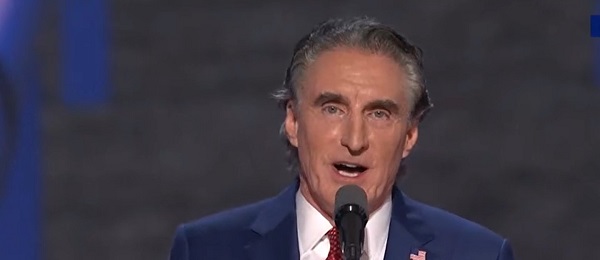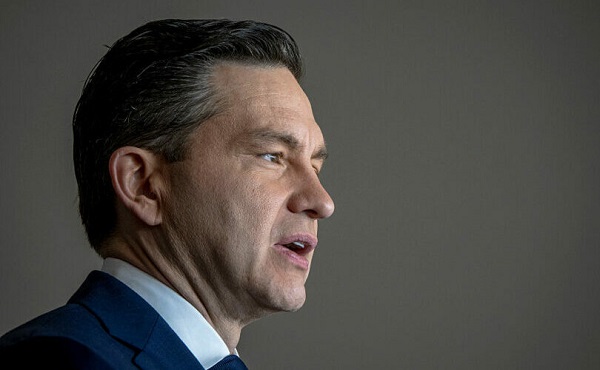Daily Caller
Trump Energy Policies will be executed by New York Rep. Lee Zeldin and North Dakota Gov. Doug Burgum

North Dakota Gov. Doug Burgum
 From the Daily Caller News Foundation
From the Daily Caller News Foundation
Zeldin And Burgum Take On Daunting Roles In Second Trump Term
President-elect Donald Trump has set Washington, D.C. afire over the past week with a series of controversial picks for cabinet-level offices and other senior advisory positions. The Senate confirmation hearings for nominees like Robert F. Kennedy, Jr., Matt Gaetz, Pete Hegseth and Tulsi Gabbard are destined to be must-see TV, events Congress could use to help cut the federal deficit by airing in pay-per-view format.
But the nominees whose offices have the biggest impact on energy policy are likely to be among the least controversial announced so far. Those would be former New York Rep. Lee Zeldin to head up the Environmental Protection Agency (EPA) and North Dakota Gov. Doug Burgum to be secretary of the Department of the Interior (DOI). While many would assume the secretary of Energy would be the cabinet position to wield the most power to regulate energy companies, the reality is that these other two positions are far more impactful.
For the oil, gas and coal industries, no part of the federal government possesses greater authority to regulate their business than DOI, which oversees all leasing, mining, drilling and minerals production related to federal lands and waters. The U.S. government is the largest landowner in the country, owning large percentages of the lands in the intermountain West under which some of the biggest domestic reserves of these mineral resources exist. Specific regions of these western states are also prime locations for wind and solar development.
North Dakota is a state rich in mineral reserves and is one of several states in which federal lands are intermingled with state and private landholdings. As governor, Burgum has had to grapple with the same array of permitting, leasing and multiple-use issues he will now be assigned to oversee at DOI. One of his main tasks will be to reinvigorate a federal leasing program that has been held dormant in violation of an array of laws and regulations by current Interior Secretary Deb Haaland, a longtime anti-development activist.
At EPA, Zeldin will be faced with the daunting task of bending a massive bureaucracy that has been packed with direct hires from billionaire-funded climate-alarm groups to get with the Trump agenda. One of Zeldin’s immediate major tasks will be to find ways to streamline the agency’s permitting and approval processes.
The slowness of permitting and delegations of authority at the agency have become bottlenecks to progress in meeting some of the carbon reduction goals laid out in the Inflation Reduction Act (IRA), President Joe Biden’s signature piece of legislation. Barring an unlikely major rewrite or repeal of the IRA, those goals will remain among the priorities that Zeldin will find on his plate when he assumes office next year.
While the common perception of the Trump energy-and-climate agenda focuses on its “drill, baby, drill” aspects, it is key to remember that former President Trump did not abandon U.S. carbon reduction coals in his first term and has not pledged to do that in the second term to come. In fact, U.S. carbon emissions fell significantly across Trump’s previous four years in office.
Both Zeldin and Burgum will also make a high priority of reviewing the massive pile of new regulations put in place by the Biden administration, which total to more new pages published in the Federal Register than any other presidency, and then working to eliminate or modify many of them. This is a daunting task that could prove overwhelming given the inevitable obstruction and pushback by the career bureaucracy within these agencies and departments.
Given the way the Trump overall agenda seems to be shaping up, Zeldin and Burgum will be taking on these administrative tasks simultaneously with Trump’s goals of cutting staff and even moving entire agencies to locations outside of Washington, D.C. They will also have to be managed in conjunction with Trump’s so-called Department of Government Efficiency to be run by Elon Musk and Vivek Ramaswamy.
What it all portends is a period of upheaval and radical change not just at EPA and DOI, but across the entire federal structure. Given that the U.S. system of government was designed by the country’s founders to inhibit radical change, we are in for some interesting times indeed.
David Blackmon is an energy writer and consultant based in Texas. He spent 40 years in the oil and gas business, where he specialized in public policy and communications.
Business
Ted Cruz, Jim Jordan Ramp Up Pressure On Google Parent Company To Deal With ‘Censorship’

From the Daily Caller News Foundation
By Andi Shae Napier
Republican Texas Sen. Ted Cruz and Republican Ohio Rep. Jim Jordan are turning their attention to Google over concerns that the tech giant is censoring users and infringing on Americans’ free speech rights.
Google’s parent company Alphabet, which also owns YouTube, appears to be the GOP’s next Big Tech target. Lawmakers seem to be turning their attention to Alphabet after Mark Zuckerberg’s Meta ended its controversial fact-checking program in favor of a Community Notes system similar to the one used by Elon Musk’s X.
Cruz recently informed reporters of his and fellow senators’ plans to protect free speech.
Dear Readers:
As a nonprofit, we are dependent on the generosity of our readers.
Please consider making a small donation of any amount here. Thank you!
“Stopping online censorship is a major priority for the Commerce Committee,” Cruz said, as reported by Politico. “And we are going to utilize every point of leverage we have to protect free speech online.”
Following his meeting with Alphabet CEO Sundar Pichai last month, Cruz told the outlet, “Big Tech censorship was the single most important topic.”
Jordan, Chairman of the House Judiciary Committee, sent subpoenas to Alphabet and other tech giants such as Rumble, TikTok and Apple in February regarding “compliance with foreign censorship laws, regulations, judicial orders, or other government-initiated efforts” with the intent to discover how foreign governments, or the Biden administration, have limited Americans’ access to free speech.
“Throughout the previous Congress, the Committee expressed concern over YouTube’s censorship of conservatives and political speech,” Jordan wrote in a letter to Pichai in March. “To develop effective legislation, such as the possible enactment of new statutory limits on the executive branch’s ability to work with Big Tech to restrict the circulation of content and deplatform users, the Committee must first understand how and to what extent the executive branch coerced and colluded with companies and other intermediaries to censor speech.”
Jordan subpoenaed tech CEOs in 2023 as well, including Satya Nadella of Microsoft, Tim Cook of Apple and Pichai, among others.
Despite the recent action against the tech giant, the battle stretches back to President Donald Trump’s first administration. Cruz began his investigation of Google in 2019 when he questioned Karan Bhatia, the company’s Vice President for Government Affairs & Public Policy at the time, in a Senate Judiciary Committee hearing. Cruz brought forth a presentation suggesting tech companies, including Google, were straying from free speech and leaning towards censorship.
Even during Congress’ recess, pressure on Google continues to mount as a federal court ruled Thursday that Google’s ad-tech unit violates U.S. antitrust laws and creates an illegal monopoly. This marks the second antitrust ruling against the tech giant as a different court ruled in 2024 that Google abused its dominance of the online search market.
Daily Caller
Daily Caller EXCLUSIVE: Trump’s Broad Ban On Risky Gain-Of-Function Research Nears Completion


From the Daily Caller News Foundation
By Emily Kopp
President Donald Trump could sign a sweeping executive order banning gain-of-function research — research that makes viruses more dangerous in the lab — as soon as May 6, according to a source who has worked with the National Security Council on the issue.
The executive order will take a broad strokes approach, banning research amplifying the infectivity or pathogenicity of any virulent and replicable pathogen, according to the source, who requested anonymity to speak candidly about the anticipated executive action. But significant unresolved issues remain, according to the source, including whether violators will be subject to criminal penalties as bioweaponeers.
The executive order is being steered by Gerald Parker, head of the White House Office of Pandemic Preparedness and Response Policy, which has been incorporated into the NSC. Parker did not respond to requests for comment.
Dear Readers:
As a nonprofit, we are dependent on the generosity of our readers.
Please consider making a small donation of any amount here. Thank you!
In the process of drafting the executive order, Parker has frozen out the federal agencies that have for years championed gain-of-function research and staved off regulation — chiefly Anthony Fauci’s former institute, the National Institute of Allergy and Infectious Diseases at the National Institutes of Health.
The latest policy guidance on gain-of-function research, unveiled under the Biden administration in 2024, was previously expected to go into effect May 6. According to a March 25 letter cosigned by the American Society for Microbiology, the Association for Biosafety and Biosecurity International, and Council on Governmental Relations, organizations that conduct pathogen research have not received direction from the NIH on that guidance — suggesting the executive order would supersede the May 6 deadline.
The 2024 guidance altered the scope of experiments subject to more rigorous review, but charged researchers, universities and funding agencies like NIH with its implementation, which critics say disincentivizes reporting. Many scientists say that researchers and NIH should not be the primary entities conducting cost–benefit analyses of pandemic virus studies.
Parker previously served as the head of the National Science Advisory Board for Biosecurity (NSABB), a group of outside experts that advises NIH on biosecurity matters, and in that role recommended that Congress stand up a new government agency to advise on gain-of-function research. Former Centers for Disease Control and Prevention Director Robert Redfield has also endorsed moving gain-of-function research decision making out of the NIH to an independent commission.
“Given the well documented lapses in the NIH review process, policymakers should … remove final approval of any gain-of function research grants from NIH,” Redfield said in a February op-ed.
It remains to be seen whether the executive order will articulate carveouts for gain-of-function research without risks of harm such as research on non-replicative pseudoviruses, which can be used to study viral evolution without generating pandemic viruses.
It also remains to be seen whether the executive order will define “gain-of-function research” tightly enough to stand up to legal scrutiny should a violator be charged with a crime.
Risky research on coronaviruses funded by the NIH at the Wuhan Institute of Virology through the U.S. nonprofit EcoHealth Alliance typifies the loopholes in NIH’s existing regulatory framework, some biosecurity experts say.
Documents obtained through the Freedom of Information Act in 2023 indicated that EcoHealth Alliance President Peter Daszak submitted a proposal to the Pentagon in 2018 called “DEFUSE” describing gain-of-function experiments on viruses similar to SARS-CoV-2 but downplayed to his intended funder the fact that many of the tests would occur in Wuhan, China.
Daszak and EcoHealth were both debarred from federal funding in January 2025 but have faced no criminal charges.
“I don’t know that criminal penalties are necessary. But we do need more sticks in biosafety as well as carrots,” said a biosecurity expert who requested anonymity to avoid retribution from his employer for weighing in on the expected policy. “For instance, biosafety should be a part of tenure review and whether you get funding for future work.”
Some experts say that it is likely that the COVID-19 crisis was a lab-generated pandemic, and that without major policy changes it might not be the last one.
“Gain-of-function research on potential pandemic pathogens caused the COVID-19 pandemic, killing 20 million and costing $25 trillion,” said Richard Ebright, a Rutgers University microbiologist and longtime critic of high-risk virology, to the Daily Caller News Foundation. “If not stopped, gain-of-function research on potential pandemic pathogens likely will cause future lab-generated pandemics.”
-

 2025 Federal Election2 days ago
2025 Federal Election2 days agoStudy links B.C.’s drug policies to more overdoses, but researchers urge caution
-

 2025 Federal Election2 days ago
2025 Federal Election2 days agoCarney’s Hidden Climate Finance Agenda
-

 Business2 days ago
Business2 days agoIs Government Inflation Reporting Accurate?
-

 2025 Federal Election2 days ago
2025 Federal Election2 days agoWhen it comes to pipelines, Carney’s words flow both ways
-

 2025 Federal Election2 days ago
2025 Federal Election2 days agoPolls say Canadians will give Trump what he wants, a Carney victory.
-

 2025 Federal Election1 day ago
2025 Federal Election1 day agoThe Anhui Convergence: Chinese United Front Network Surfaces in Australian and Canadian Elections
-

 2025 Federal Election1 day ago
2025 Federal Election1 day agoCarney Liberals pledge to follow ‘gender-based goals analysis’ in all government policy
-

 2025 Federal Election1 day ago
2025 Federal Election1 day agoPoilievre’s Conservatives promise to repeal policy allowing male criminals in female jails






